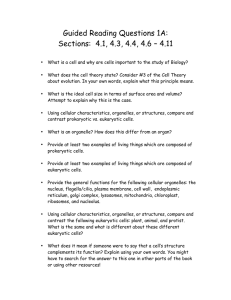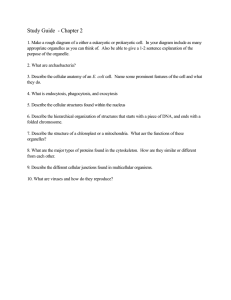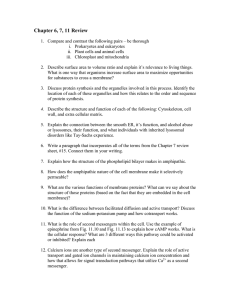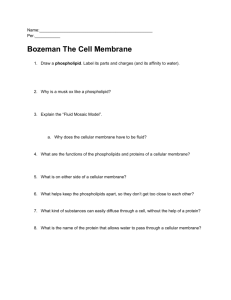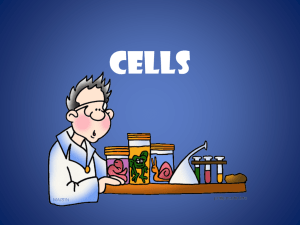Chapter 7: Cell Structure and
advertisement
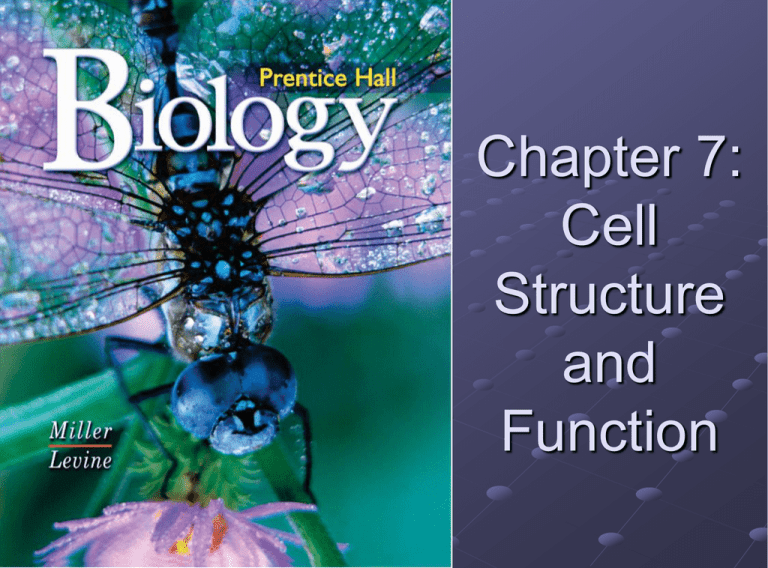
Chapter 7: Cell Structure and Function 7-1 Life Is Cellular Robert Hooke (1635-1703) English Scientist First to use the microscope to observe cells Coined the term “cell” Looked at cork cells 7-1 Life Is Cellular Anton van Leeuwenhoek 1632-1723 Dutch scientist Invented the first compound microscope First to observe LIVING cells Blood cells and protists 7-1 Life Is Cellular Robert Brown 1773-1858 Scottish botanist In 1831 he was the first person to observe the nucleus of a cell 7-1 Life Is Cellular Developing Cell Theory 1838 Schleiden Said “all plants are made up of cells” 1804-1881 Schwann Said “all animals are made up of cells” 1810-1882 7-1 Life Is Cellular Rudolph Virchow 1855 “All cells arise only from preexisting cells.” 7-1 Life Is Cellular Cell Theory Overview 1. All organisms are made of one or more cells. 1. All cells carry on life activities. 2. New cells arise only from other living cells. 7-1 Life Is Cellular Exploring the Cell There are 3 major types of microscopes 1. Light Microscope • • • • • Magnifies Up to 1,000 X Eyepiece magnifies 10X Total magnification calculation: eyepiece X objective being used. Exampleeyepiece (10X) times low power objective (4X) = 40X Light must pass through. Uses slides, can observe living things 7-1 Life Is Cellular Exploring the Cell 2. Dissecting Microscope Magnifies 10 to 30 times Eyepiece magnifies 10X Objectives: 1X and 2X (3X) Used to magnify objects that light cannot pass through Used mostly by research scientists and jewelers Advantage: objects are 3-D Disadvantage: can’t view small objects 7-1 Life Is Cellular Exploring the Cell 3. Electron Microscope Uses electrons to illuminate objects Can magnify from 30,000 to 9 million times Two types: Transmission and Scanning Costly to own and maintain Can only be used to look at dead specimens Used for cytology, forensics, and virology 7-1 Life Is Cellular Exploring the Cell TEM -Transmission Electron Microscope •TEM- thin slices need to be made to have clear images, images are 2-D •Useful for studying internal structures 7-1 Life Is Cellular Exploring the Cell •SEM- Scanning Electron Microscope samples do not need to be cut, are in 3-D • Useful for studying external structure 7-1 Life Is Cellular Two Types of Cells 1. PROKARYOTE: do NOT contain a membrane bound nucleus (all bacteria are prokaryotes) 2. EUKARYOTE: DO contain a membrane bound nucleus, and most have other specialized organelles. 7-1 Life Is Cellular Prokaryotes and Eukaryotes 7-1 Life Is Cellular Prokaryotic vs Eukaryotic PROKARYOTIC Simplest form Lack membrane bound structures Example: bacteria and some protists EUKARYOTIC Most common Possess membrane bound structures and a nucleus Found in most living things 7-1 Life Is Cellular Cell Size 1. Cells are small because materials need to get into and out of the cell at a rate that will meet the cell’s needs. 2. Surface area – to – volume ratio a. Larger surface area/volume ratio, the more materials a cell can exchange b. As cell size increases, surface area to volume ration decreases 7-1 Life Is Cellular Cell Size 7-2 Eukaryotic Cell Structure Common cell structures Cell Membrane Thin flexible barrier around the cell Nucleus Contains genetic material Controls cell’s activities Cytoplasm Material inside the cell surrounding the organelles 7-4 Diversity of Cellular Life ANIMAL CELL VS. PLANT CELL 7-2 Eukaryotic Cell Structure PLANT CELL 7-2 Eukaryotic Cell Structure ANIMAL CELL 7-2 Eukaryotic Cell Structure Cell Organelles 7-2 Eukaryotic Cell Structure Cell Organelles Organelle “little organ” Found only inside eukaryotic cells All the stuff in between the organelles is cytosol Everything in a cell except the nucleus is cytoplasm 7-2 Eukaryotic Cell Structure Cell Membrane Boundary of the cell Made of a phospholipid bilayer 7-2 Eukaryotic Cell Structure Nucleus Control center of the cell Contains DNA Surrounded by a double membrane Usually the easiest organelle to see under a microscope Usually one per cell 7-2 Eukaryotic Cell Structure Cytoskeleton Acts as skeleton and muscle Provides shape and structure Helps move organelles around the cell Made of three types of filaments Endoplasmic Reticulum 7-2 Eukaryotic Cell Structure A.k.a. “ER” Connected to nuclear membrane Highway of the cell Rough ER: studded with ribosomes; it makes proteins Smooth ER: no ribosomes; it makes lipids 7-2 Eukaryotic Cell Structure Ribosome Site of protein synthesis Found attached to rough ER or floating free in cytosol Produced in a part of the nucleus called the nucleolus That looks familiar…what is a polypeptide? 7-2 Eukaryotic Cell Structure Golgi Apparatus Looks like a stack of plates Stores, modifies and packages proteins Molecules transported to and from the Golgi by means of vesicles 7-2 Eukaryotic Cell Structure Lysosomes Garbage disposal of the cell Contain digestive enzymes that break down wastes Which organelles do lysosomes work with? 7-2 Eukaryotic Cell Structure Mitochondria “Powerhouse of the cell” Cellular respiration occurs here to release energy for the cell to use Bound by a double membrane Has its own strand of DNA 7-2 Eukaryotic Cell Structure Chloroplast Found only in plant cells Contains the green pigment chlorophyll Site of food (glucose) production Bound by a double membrane 7-2 Eukaryotic Cell Structure Cell Wall Found in plant and bacterial cells Rigid, protective barrier Located outside of the cell membrane Made of cellulose (fiber) 7-2 Eukaryotic Cell Structure Vacuoles Large central vacuole usually in plant cells Many smaller vacuoles in animal cells Storage container for water, food, enzymes, wastes, pigments, etc. What type of microscope may have been used to take this picture? 7-2 Eukaryotic Cell Structure Centriole Helps with cell division Usually found only in animal cells Made of microtubules Where else have we talked about microtubules? 7-2 Eukaryotic Cell Structure Quick Review Which organelle is the control center of the cell? nucleus Which organelle holds the cell together? cell membrane Which organelles are not found in animal cells? cell wall, central vacuole, chloroplasts Which organelle helps plant cells make food? chloroplasts What does E.R. stand for? endoplasmic reticulum 7-4 Diversity of Cellular Life What are the parts? 7-3 Cell Boundaries Cell Boundaries: Cell Wall Found in plants, algae, fungi, and nearly all prokaryotes. MAIN FUNCTION: provide support & protection for the cell. Plants have cellulose Animal cells DO NOT have cell walls! Cell Boundaries: Cell Membrane 7-3 Cell Boundaries Controls what materials move in and out Helps to maintain homeostasis Similar to the “city limits” Made up of three substances : Lipids, proteins, and carbohydrates Cell Boundaries: Cell Membrane 7-3 Cell Boundaries Fluid-Mosaic Model 7-15 The StructureCell of the Cell Figure Boundaries: Cell Membrane Membrane 7-3 Cell Boundaries Section 7-3 Fluid-Mosaic Model Outside of cell Proteins Carbohydrate chains Cell membrane Inside of cell (cytoplasm) Go to Section: Protein channel Lipid bilayer 7-3 Cell Boundaries Selectively permeable Some substances pass through while others may not. Regulates chemical composition Maintains homeostasis 7-3 Cell Boundaries Maintaining Homeostasis All cells must regulate what materials enter & leave; sometimes no energy is required to do this, other times energy is required Passive transport – no energy is required to move substances from an area of high concentration to an area of low concentration 7-3 Cell Boundaries Types of Passive Transport Diffusion – the movement of a solute from an area of high conc. To an area of low conc. Equilibrium is reached when an equal number of molecules move in both directions 7-3 Cell Boundaries Diffusion Movement of molecules from a region of high concentration to a region of low concentration 7-3 Cell Boundaries Types of Passive Transport Osmosis – the diffusion of water across a membrane from a region of high water concentration to a region of low water concentration http://www.youtube.com/watch?v=sdiJtDRJQEc (osmosis animation) 7-3 Cell Boundaries Osmosis Diffusion of WATER across a selectively permeable membrane from a region of high water concentration to a region of low water concentration. Osmotic pressure = Increased pressure resulting from osmosis 7-3 Cell Boundaries Osmosis Higher Concentration of Water Water molecules Cell membrane Lower Concentration of Water Sugar molecules 7-3 Cell Boundaries Types of Osmotic Solutions Isotonic solution – solution has the same solute concentration as that of the living cell, there is no net movement of H2O 7-3 Cell Boundaries Isotonic Solution Same concentration of dissolved substances in solution as there is in the cell Same water concentrations Net result No net gain or loss of water 7-3 Cell Boundaries Types of Osmotic Solutions Hypertonic solution– solution has a higher solute concentration than the inside of the cell; H2O moves out of the cell; animal cell will shrink (crenate); vacuole collapses in plant cells 7-3 Cell Boundaries Hypertonic Solution A high concentration of dissolved substances outside the cell More water in the cell than outside the cell Net result : cell loses water and contracts 7-3 Cell Boundaries Types of Osmotic Solutions Hypotonic solution – solution has a lower solute concentration than the inside of the cell; H2O moves into the cell; animal cell will burst (lyse); plant cell will not (why?) 7-3 Cell Boundaries Hypotonic Solution Lower concentration of dissolved substances in solution than in the cell More water outside the cell than inside the cell Net result : cell fills and may burst 7-3 Cell Boundaries Types of Osmotic Solutions 7-3 Cell Boundaries Types of Osmotic Solutions 7-3 Cell Boundaries You can see the effects of Osmotic Pressure Osmotic pressure allows plant stems to stand against gravity 7-3 Cell Boundaries Types of Passive Transport Facilitated diffusion – process by which transport proteins carry certain molecules across a membrane from high concentration to low concentration 7-3 Cell Boundaries Facilitated Diffusion vs. Active Transport FACILITATED DIFFUSION No energy needed Concentration gradient determines movement Uses protein channels ACTIVE Usually works against the concentration. gradient Often a transport protein helps the movement (ATP) 7-3 Cell Boundaries Active Transport Energy is required to move substances from an area of low concentration to an area of high concentration; allows cells to have internal environments that are different chemically from the external environment 7-3 Cell Boundaries Active transport requires energy! 7-3 Cell Boundaries Types of Active Transport Molecular transport - proteins in the cell membrane work as “pumps” to move substances against the concentration gradient 7-3 Cell Boundaries Molecular Transport • Small molecules & ions are carried across the cell membrane by protein pumps • Examples of pumps include: calcium, potassium, and sodium 7-3 Cell Boundaries Sodium-potassium pump 7-3 Cell Boundaries Types of Active Transport Endocytosis - process by which a cell takes material into the cell by infolding of the cell membrane Phagocytosis – large particles taken in Pinocytosis – H2O or small particles are taken in Exocytosis – process by which cell releases large amounts of material; vacuole membrane fuses with the cell membrane 7-3 Cell Boundaries Types of Active Transport 7-3 Cell Boundaries Bulk Transport Defined: The transportation of large molecules and even solid clumps of material Two main types: Exocytosis Endocytosis 7-3 Cell Boundaries Phagocytosis“cell eating”; useful for unicellular organisms to take in food or for WBC’s to engulf and destroy bacteria Ex: Amoeba feeding Phagocytosis is specific to what it transports 7-4 Diversity of Cellular Life Cells Need to communicate – send and receive signals with each other 7-4 Diversity of Cellular Life Diversity of Cellular Life Unicellular- one celled organisms Bacterial, some protists Colony – a group of unicellular organisms living together Multicellular - more than one cell; cells are specialized to perform a specific function 7-4 Diversity of Cellular Life Diversity of Cellular Life Unicellular Multicellular 7-4 Diversity of Cellular Life Levels of Organization 7-4 Diversity of Cellular Life Tissues: A group of cells which are structurally similar and perform the same function. 7-4 Diversity of Cellular Life Examples of Tissues Nerve Tissue Nerve Cell 7-4 Diversity of Cellular Life 1. Epithelial Tissue Tissue that covers surfaces inside and outside the body Example: skin Sheets of closely packed cells 7-4 Diversity of Cellular Life 2. Connective Tissue Supports and binds tissues and organs together Widely separated cells EX. bone, blood 7-4 Diversity of Cellular Life 3. Nervous Tissue Specialized for electrical impulse transport Ex. brain, spinal cords, nerves 7-4 Diversity of Cellular Life 4. Muscle Tissue Specialized for contraction Lots of mitochondria 7-4 Diversity of Cellular Life Organs Group of tissues that work together to perform a specific function Ex. heart, stomach, flower 7-4 Diversity of Cellular Life Organ system Group of organs that perform a specific task Ex. digestive, skeletal, circulatory 7-4 Diversity of Cellular Life 5. Levels of Organization cells --> tissues --> organs --> organ systems --> organisms Tissue – is a group of similar cells that work together to perform a function. 7-4 Diversity of Cellular Life Organ – is a group of tissues that work together to do a job. 7-4 Diversity of Cellular Life Organ systemis a group of organs that work together to do a certain job. 7-4 Diversity of Cellular Life Examples of organisms Crow Organism – is a living thing that can be made of one or more cells. Human Amoeba Elephant Bonobo



